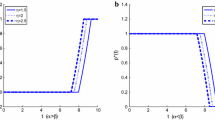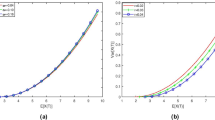Abstract
A Bayesian adaptive control approach to the combined optimal investment/reinsurance problem of an insurance company is studied. The insurance company invests in a money market and a capital market index with an unknown appreciation rate, or “drift”. Using a Bayesian approach, the unknown drift is described by an unobservable random variable with a known (prior) probability distribution. We assume that the risk process of the company is governed by a diffusion approximation to the compound Poisson risk process. The company also purchases reinsurance. The combined optimal investment/reinsurance problem is formulated as a stochastic optimal control problem with partial observations. We employ filtering theory to transform the problem into one with complete observations. The control problem is then solved by the dynamic programming Hamilton–Jacobi–Bellman (HJB) approach. Semi-analytical solutions are obtained for the exponential utility case.
Similar content being viewed by others
References
Cox JC, Huang C (1989) Optimal consumption and portfolio policies when asset prices follow a diffusion process. J Econ Theory 49(1): 33–83
He H, Pearson ND (1991) Consumption and portfolio policies with incomplete markets and short-sale constraints: the finite-dimensional case. Math Financ 1(3): 1–10
Karatzas I (1989) Optimization problems in the theory of continuous trading. SIAM J Control Optim 27(6): 1221–1259
Karatzas I, Lehoczky JP, Shreve SE, Xu GL (1991) Martingale and duality methods for utility maximization in a incomplete market. SIAM J Control Optim 29(3): 702–730
Merton RC (1971) Optimum consumption and portfolio rules in a continuous-time model. J Econ Theory 3(4): 373–413
Merton RC (1990) Continuous-time finance. Blackwell Publishers, London
Zhang X, Siu TK, Meng Q (2010) Portfolio Selection in the enlarged Markovian Regime-switching market. SIAM J Control Optim 48(5): 3368–3388
Browne S (1995) Optimal investment policies for a firm with a random risk process: exponential utility and minimizing the probability of ruin. Math Oper Res 20(4): 937–958
Bayraktar E, Young VR (2007) Minimizing the probability of lifetime ruin under borrowing constraints. Insurance 41(1): 196–221
Liu CS, Yang H (2004) Optimal investment for an insurer to minimize its probability of ruin. North Am Actuar J 8(2): 11–31
Promislow SD, Young VR (2005) Minimizing the probability of ruin when claims follow Brownian motion with drift. North Am Actuar J 9(3): 109–128
Schmidli H (2001) Optimal proportional reinsurance policies in a dynamic setting. Scand Actuar J 2001(1): 55–68
Schmidli H (2002) On minimising the ruin probability by investment and reinsurance. Ann Appl Probab 12(3): 890–907
Zhang X, Siu TK (2009) Optimal investment and reinsurance of an insurer with model uncertainty. Insur Math Econ 45(1): 81–88
Zhang X, Zhou M, Guo JY (2007) Optimal combinational quota-share and excess-of-loss reinsurance policies in a dynamic setting. Appl Stoch Models Bus Indus 23(1): 63–71
Lakner P (1995) Utility maximization with partial information. Stoch Process Appl 56(2): 247–273
Lakner P (1998) Optimal trading strategy for an investor: the case of partial information. Stoch Process Appl 76(1): 77–97
Pham H, Quenez MC (2001) Optimal portfolio in partially observed stochastic volatility models. Ann Appl Probab 11(1): 210–238
Karatzas I, Zhao X (2001) Bayesian adaptive portfolio optimization. Handbook of mathematical finance. Cambridge University Press, Cambridge, pp 632–670
Sass J, Haussmann UG (2004) Optimizing the terminal wealth under partial information: The drift process as a continuous time Markov chain. Financ Stoch 8(4): 553–577
Rieder U, Bäuerle N (2005) Portfolio optimization with unobservable Markov-modulated drift process. J Appl Probab 42: 362–378
Bäuerle N, Rieder U (2007) Portfolio optimization with jumps and unobservable intensity process. Math Financ 17(2): 205–224
Callegaro G, Di Masil GB, Runggaldier WJ (2006) Portfolio optimization in discontinuous markets under incomplete information. Asia-Pac Financ Mark 13(4): 373–394
Xiong J, Zhou XY (2008) Mean–variance portfolio selection under partial information. SIAM J Control Optim 46(1): 156–175
Choulli T, Taksar M, Zhou XY (2003) A diffusion model for optimal dividend distribution for a company with constraints on risk control. SIAM J Control Optim 41(6): 1946–1979
Bäuerle Nicole (2005) Benchmark and mean–variance problems for insurers. Math Methods Oper Res 62(1): 159–165
Grandell J (1991) Aspects of risk theory. Springer-Verlag, New York
Højgaard B, Taksar M (2004) Optimal dynamic portfolio selection for a corporation with controllable risk and dividend distribution policy. Quant Financ 4(3): 315–327
Elliott RJ (1982) Stochastic calculus and applications. Springer-Verlag, New York
Kallianpur G (1980) Stochastic filtering theory. Springer-Verlag, New York
Rogers LCG, Williams D (1987) Diffusions, Markov processes, and martingales, vol. 2. Wiley, Chichester
Fleming WH, Soner HM (1993) Controlled Markov processes and viscosity solutions. Springer-Verlag, New York
Author information
Authors and Affiliations
Corresponding author
Rights and permissions
About this article
Cite this article
Zhang, X., Elliott, R.J. & Siu, T.K. A Bayesian approach for optimal reinsurance and investment in a diffusion model. J Eng Math 76, 195–206 (2012). https://doi.org/10.1007/s10665-011-9531-z
Received:
Accepted:
Published:
Issue Date:
DOI: https://doi.org/10.1007/s10665-011-9531-z




